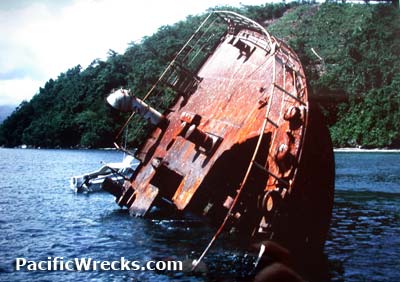|
|
|
|
| Missing In Action (MIA) | Prisoners Of War (POW) | Unexploded Ordnance (UXO) |
| Chronology | Locations | Aircraft | Ships | Submit Info | How You Can Help | Donate |
|
| IJN Cargo 6,702 Tons 486' x 58' x 32' Deck gun  3rd BG February 28, 1943  Australian Army c1945  Rust In Peace 1970s  Richard Leahy 1980s  Rod Pearce 1980s |
Ship History Built by Mitsubishi Zosenho, K. K. Laid down October 13, 1936. Launched January 30, 1937 as Kōtoku Maru, also spelled Kotoku Maru in English. Completed May 15, 1937 and delivered to Hiroumi Shoji K. K. and registered in Osaka for use as a refrigerated cargo ship with "X" on the funnel. Wartime History On September 19, 1937 requisitioned by the Imperial Japanese Navy (IJN) and registered in the Sasebo Naval District as an auxiliary transport with Captain Seishiro Sato appointed as supervisor at Sasebo and a week later conversion into an auxiliary ammunition ship and armed with a deck gun and anti-aircraft guns. On June 29, 1942 departs Truk for as part of a thirteen ship convoy including light cruiser Yuari and destroyers Uzuki and Oite escorting transports including this ship plus Kanyoh Maru, Azumasan Maru, Meiyo Maru and Matumoto Maru and Nojima Maru. On July 6, 1942 arrives off the north coast of Guadalcanal. On July 9, 1942 lands at Renadi 250 personnel from the Hara Construction Force and security troops on Guadalcanal to build Lunga Airfield, and then delivered 50 other personnel to Gavutu, to build installations. On July 29, 1942 this ship was en route to Buna and was caught off Gona by A-24 dive bombers. Hit by a bomb from the second wave and damaged its no. 5 hatch, forcing it to unload 263 men, mostly troops of the 15th Independent Engineers on motor launches to reach shore. The cargo was unable to be unloaded. Although damaged, the ship was able to leave the area under reduced power and returning to Lae late in the evening for temporary repairs, then attempted to return to Buna to finish unloading. Sinking History On July 30, 1942 in the afternoon off Salamaua attempting to return to Buna, spotted by B-17 Flying Fortresses from 19th Bombardment Group (19th BG) and hit by at least three 500 lbs bombs and further damaged. Afterwards, the Kotoku Maru drifted and ran aground off Salamaua. Shipwreck After grounding, Allied coastwatchers in the vicinity observed the Japanese performing salvage on stricken vessel and removing cargo before abandoning the ship. Afterwards, the shipwreck of the Kotoku Maru remained level on the surface and was clearly visible from the air. The wreck was mistaken as an active ship and inadvertently targeted by Allied aircraft bombing Salamaua. Following the Australian liberation of Salamaua during the middle of September 1942 the wreck was inspected. On July 15, 1944 Caledonian Salvor removed winches and other gear from the shipwreck. Until at least 1945, the vessel remained in an upright position. At some point, the bow section was removed, cut off or severely damaged. By the 1970s, the wreck was still largely intact, resting on its side. By the 1980s, only the stern section was visible above water and the rest of the wreck settled in 25m of water. Today, the shipwreck is a good wreck for novice divers. The best season to dive is between November and April, when visibility is usually 10 to 20m, depending on the prevailing weather. Points of interest include the ammunition locker with shells inside. This wreck also offers excellent night dives. References Also misspelled as "Kotoko Maru" [sic] in some sorces. Kotoku Maru : Lloyd's Register of Ships Lloyd's of London Lloyd's Register - Kotoku Maru 1937-38 [PDF] Lloyd's of London Lloyd's Register - Kotoku Maru 1938-39 [PDF] Lloyd's of London Lloyd's Register - Kotoku Maru 1939-40 [PDF] Lloyd's of London Lloyd's Register - Kotoku Maru 1941-42 [PDF] Lloyd's of London Lloyd's Register - Kotoku Maru 1942-43 [PDF] Lloyd's of London Lloyd's Register - Kotoku Maru 1943-44 [PDF] Combined Fleet - IJN Kotoku Maru: Tabular Record of Movement Rust In Peace (1975) has a photo of this wreck in the early 1970s Hell's Island (2008) pages 70-71 "X Marks the Spot" by David Pennefather Thanks to Richard Leahy and Rod Peace for additional information Contribute
Information |
0-25m Photo Archive |
| Discussion Forum | Daily Updates | Reviews | Museums | Interviews & Oral Histories |
|